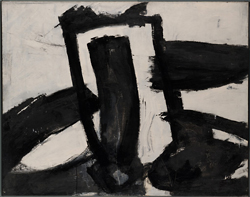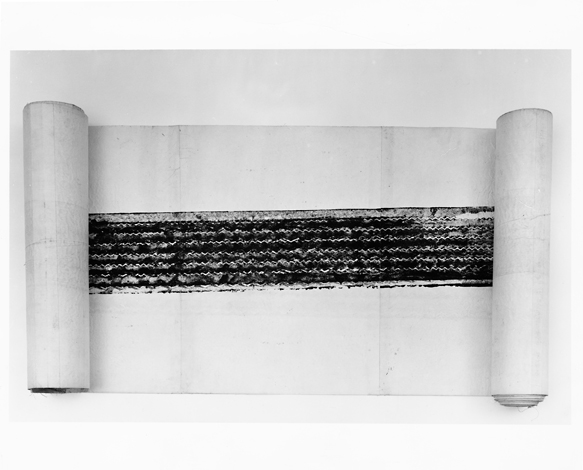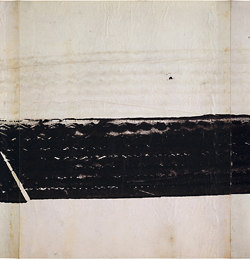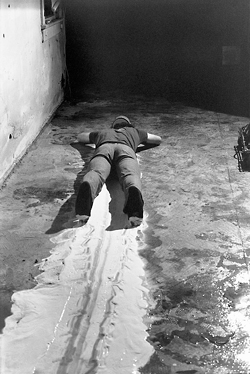In the fall of 1953,1 Robert Rauschenberg asked composer John Cage (1912–1992) to bring his Model A Ford to Fulton Street in Lower Manhattan, where Rauschenberg lived and worked. The artist then poured paint in front of the car’s rear tire and directed Cage to drive slowly over twenty sheets of paper that he had glued together. The resulting print records a twenty-two-foot tread mark, about three revolutions of the wheel.2 In the decades since its creation, Automobile Tire Print has been interpreted as a monoprint, a drawing, a performance, a process piece, and a primary example of Rauschenberg’s use of indexical marks. Surprisingly, few scholars have considered it within Rauschenberg’s immediate art historical context—that is, the work and thinking of artists associated with action painting and the New York School—or connected it to Cage’s ideas about process, time, and the structure of music and silence, which intersected with Rauschenberg’s evolving approach to his art and informed his turn away from Abstract Expressionism.
In addition to Automobile Tire Print, Rauschenberg created numerous works between 1951 and 1953 that suggest a nuanced understanding of prevailing artistic conventions and reflect a desire to simultaneously claim a place among and distance himself from his immediate peers. Cage’s thinking became central to this effort in summer 1952, when their friendship solidified during the summer session at Black Mountain College, near Asheville, North Carolina.3 The following spring, after returning to New York following an eight-month trip to Europe, Rauschenberg found a studio space downtown, near Cage’s. By the time Automobile Tire Print was created in fall 1953, Cage and Rauschenberg had been living and working in very close proximity for six months, and they were engaged in a rich exchange of energy and ideas. In the same period, Rauschenberg immersed himself in all aspects of the New York art world, attending lectures by major critics and artists at the Club, the legendary space where artists associated with the New York School gathered for debate beginning in 1948, and frequently viewing recent work by Willem de Kooning (1904–1997), Jackson Pollock (1912–1956), Franz Kline (1910–1962), Philip Guston (1913–1980), and Barnett Newman (1905–1970), among others, all of whom were acquaintances of varying familiarity.

Automobile Tire Print reflects a high degree of intimacy with this artistic community, although the full nature of its engagement with this context has yet to be fully explored. In many respects Automobile Tire Print is similar to Rauschenberg’s Erased de Kooning Drawing. Made within months, if not weeks, of each other, both works have been discussed as recordings of performative acts, and both derive much of their meaning from their processes of making and their challenge to accepted art world values.4 With a sophisticated and slightly irreverent sense of humor, Erased de Kooning Drawing infamously squared off against the sanctity of original works of art, both celebrating and obliterating de Kooning’s place as a figurehead. A similarly edgy homage lurks within Automobile Tire Print. Rachel Rosenthal (1926–2015), an artist and performer who was close to Rauschenberg in 1954–55, has suggested that it might be a wry dig at Sari Dienes’s (1898–1992) street rubbings of manhole covers and found sidewalk textures.5 In this light, the work might also be viewed in relation to Newman’s zip paintings or the broad black-on-white brushstrokes of Kline (fig. 2).6 In a gesture of acknowledgment-cum-subversion like that seen in Erased de Kooning Drawing, Rauschenberg’s use of an automobile driven by a friend to make a rich, juicy black line holds to the abstract expressionist ideal of directly capturing spontaneous artistic expression while completely upending the aggrandized notions of authorship and the autographic mark celebrated in Newman’s and Kline’s paint strokes.7 The deadpan transfer of a tire mark to paper removed his psyche and hand from the creative act and reset the terms for what it meant to be an artist in ways that correspond closely to Cage’s strategies, a point to which we will return.
The character of the mark making in Automobile Tire Print has been central to its interpretation by art historians. It was first shown publicly in 1970, when it was presented as one of Rauschenberg’s earliest prints in exhibitions organized by the Institute of Contemporary Art, Philadelphia, and the Minneapolis Institute of Arts.8 Though it has continued to be referred to as a monoprint,9 the work’s status as a print has fallen into the background over time, with scholarly interest instead focused on Rauschenberg’s use of the direct imprint or indexical mark. From his earliest days as an artist, Rauschenberg avidly explored and invented myriad ways of marking paper and canvas, using traditional tools such as paintbrushes, pencils, and woodcut blocks as well as highly unorthodox methods. As a student in 1949 at the Art Students League of New York, for example, he laid paper on the floor of the building’s entrance to capture the footprints of those entering and exiting.10 The creation of receptive surfaces on which to record, collect, or index the direct imprint of elements from the real world is especially central to the artist’s pre-1955 works.11 Leo Steinberg’s celebrated 1972 article “Reflections on the State of Criticism” isolated this particular approach to surface as collection point as the singular contribution of Rauschenberg’s works of the early 1950s, one which galvanized a new position within postwar art.12 Steinberg coined the term “flatbed picture plane” to account for this radical shift, through which “the painted surface is no longer the analogue of a visual experience of nature but of operational processes.”13 Building on Steinberg, Rosalind Krauss’s 1974 essay “Rauschenberg and the Materialized Image” offered an extended theoretical framework for understanding Rauschenberg’s widespread deployment of traced, transferred, and imprinted marks.14 Taking Automobile Tire Print as a prime example, Krauss argues that Rauschenberg’s “refusal to use the autographic mark of conventional drawing” and his “substitution of the deposited physical mark of the real thing” were means of removing the artist from the equation and grounding art in physical, collective, real-world experience.15 Numerous authors have since elaborated on this idea of the indexical mark as post-authorial,16 most recently Cornelia Butler, who argues for understanding the tire print as “a readymade line” with which Rauschenberg countered the authorial presence in Abstract Expressionism.17

Krauss has also suggested that the length and legibility of the tire mark (as both form and process) in Automobile Tire Print combine to make literal the way works of art unfurl across space.18 In such a reading, the work becomes a study of the internal mechanics of art itself, both embodying time and displaying the process of its own making. Early in its history, the tire print was shown as a scroll with various sections of the tread mark visible. Sometimes it was spooled rather tightly, with only a foot or so visible (fig. 3); on other occasions the paper was unrolled six or more feet, emphasizing the spatial extension Krauss had in mind. The work’s scroll format, with its capacity for lengthening and retraction, both implies the actions and time of viewing and recalls the span of time needed for the tire to make its mark, imputing a temporal quality.19 In addition to its overall length, two other physical aspects of the print manifest time and the work’s conditions of creation. First, as the unpainted front tire of the car passed over the paper in advance of the painted rear tire, it left a ghostly double that runs parallel to and then is overtaken by the painted line of tread. Its presence alerts the viewer to the process used to make the piece and magnifies its durational character (fig. 4). Second, the striations and gradually decreasing boldness of the painted tire’s imprint mimic the diminishing quantity of paint released from a loaded brush as it glides across the canvas. The slow fade acts as a visual analogue to a musical diminuendo and heightens the sense of time passing.

It is just such spatiotemporal qualities that have driven Automobile Tire Print’s association with performance, a theme that has dominated the literature on this piece for the past twenty years. Historians have argued that the work stands as a precedent both for the artist’s own performances in the 1960s and for the explosion of performative work in that decade.20 Paul Schimmel astutely places Automobile Tire Print on a trajectory of performative works based on the notion of capturing an indexical trace, reaching back to Pollock’s drip paintings, moving up through Rauschenberg’s blueprints, and on to Piero Manzoni’s Lineas (1959–61), Paul McCarthy’s video Face Painting—Floor, White Line (1972, fig. 5), and Ulay and Marina Abramovic’s 1977 performance Relation in Movement, in which they drove a van in a circle for sixteen hours, leaving a circle of oil drips and tire marks on a public plaza in Paris.21

The trace of a performance, the removal of authorship, the readymade line, the indexical mark—all of Automobile Tire Print’s associations resonate with and should be considered in the context of Cage’s radical ideas about silence and the removal of expression in music, ideas that arose in the early 1950s largely in response to the overwhelming discourse of masculine agency and individualist expression associated with Abstract Expressionism. From the time of his arrival in New York in 1942, Cage was engaged in a deep intellectual exchange with artists in this circle—particularly Robert Motherwell (1915–1991)—and participated in discussions and presented lectures at the Subjects of the Artist school and later at the Club.22 However, by the time Cage and Rauschenberg began work on Automobile Tire Print, Cage had articulated a sharp turn away from the ethos of the Club, specifically rejecting what Caroline A. Jones has described as the model of “the artist as a masculine solitary whose staunchly heterosexual libido drove his brush.”23 As Jones and Jonathan D. Katz have convincingly argued, silence emerged as Cage’s primary means of countering the fervently expressive, highly individualistic machismo associated with Abstract Expressionism.24 It was a construct that gave him room to act independently as an artist in a world dominated by the abstract expressionist paradigm and to create space for himself as a gay man in the atmosphere of homophobia that permeated postwar American culture. Katz identifies Cage’s silence as an ironic position, one that negated any authentic, unmediated forms of expression and reframed both composing and listening to music as self-conscious acts. For Katz, this irony is particularly effective at cutting against the dominant expressionist and heterosexual norms without overtly opposing them.25
With Cage being the more established presence in New York art circles, it follows that Rauschenberg—a slightly younger gay man working to define his own role in the same circles—would have used Cage’s strategies as a jumping-off point for his own. Cage’s silence, part of a distinctive form of ironic resistance, speaks directly to Automobile Tire Print. Just as Cage sought to decentralize the role of the composer and performer and obviate expression, Rauschenberg used Automobile Tire Print to eliminate the artist’s hand, deemphasize authorship, and counter the high individualism that was a central tenet of the work of so many of his peers. Rauschenberg’s straight transfer of the tire tread to the paper inextricably links Automobile Tire Print to the real-world moment when tire met paint, paper, and street, and thus embeds that process directly in the artwork. The lack of a paintbrush, pencil, or any traditional art-making tool or implement is worth considering, for this choice certainly removes the potential for individual expression, but it also removes the artist’s body from the art-making equation.26 To continue this reading, the use of a car instead of a brush undercut the primacy of individual touch and necessitated a collaborator. With Cage driving the car, Rauschenberg’s only “hand” in the making of the tire print was conceptualizing and directing the work—and pouring the paint in the street.27 Thus the work precludes any expression of individualism or artistic bravura, while also unseating the idea of the artist as lone wolf. Two artists gamely working together, neither of them physically touching the surface of the artwork, resulted in a razor-sharp commentary on the popular construction of the artist as individual genius willing masterworks into existence through physical and psychological exertion.
The exact nature of the collaboration in Automobile Tire Print continues to be questioned by scholars, with some wondering if Cage should be co-credited as artist.28 Rauschenberg always fully acknowledged Cage’s participation, but he stopped short of crediting him as a co-creator. Cage once laughingly referred to his role as that of “an unpaid day-laborer,”29 and he always acknowledged Rauschenberg as the originator of the idea. But perhaps Cage best captured the provocative character of the collaboration when he asked in his inimitable laconic style, “Which one of us drove the car?”30 Cage’s contributions to the project clearly went beyond his role behind the wheel. By absorbing Cage’s strategies and digesting their implications for the visual arts, Rauschenberg expanded on the mode of ironic resistance to the hermetic aesthetics and the ethos of individualism of the 1950s art world—a stance that he had developed in earlier works such as the White Paintings (1951) and Erased de Kooning Drawing—and honed a voice that stood out against the roar of Abstract Expressionism.
Notes
- In the early literature, Automobile Tire Print was dated 1951. See Edward A. Foster, Robert Rauschenberg: Prints 1948/1970 (Minneapolis: Minneapolis Institute of Arts, 1970), n.p. See also Walter Hopps, Robert Rauschenberg (Washington, D.C.: National Collection of Fine Arts, Smithsonian Institution, 1976), 31, 65. In the course of research for Robert Rauschenberg: The Early 1950s, Hopps confirmed with the artist that the piece was properly dated 1953. Walter Hopps, Robert Rauschenberg: The Early 1950s (Houston: Menil Foundation and Houston Fine Art Press, 1991), 200, 201.
- Rauschenberg stated that he poured the paint on the street and Cage rolled through it. Robert Rauschenberg, video interview by David A. Ross, Walter Hopps, Gary Garrels, and Peter Samis, San Francisco Museum of Modern Art, May 6, 1999. Unpublished transcript at the SFMOMA Research Library and Archives, N 6537 .R27 A35 1999a, 26. Although there are denser sections in the middle of the print, it appears that no additional paint was applied during the printing process. The darker patches recur rhythmically, corresponding to revolutions of the tire as the unevenly applied first coat of paint ran its course along the paper.
- Cage and Rauschenberg first met briefly in 1951. Joan Young with Susan Davidson, “Chronology,” in Robert Rauschenberg: A Retrospective, ed. Walter Hopps and Susan Davidson (New York: Solomon R. Guggenheim Museum, 1997), 551. For a chronology of Cage and Rauschenberg’s earliest intersections, see Paul B. Franklin, “Chronology,” in Dancing around the Bride: Cage, Cunningham, Johns, Rauschenberg, and Duchamp, ed. Carlos Basualdo and Erica F. Battle (Philadelphia: Philadelphia Museum of Art, 2012), 291–367; particularly 310–21 for the years 1951–58. Kay Larson offers a rich narrative of the intense exchange between Rauschenberg and Cage. Kay Larson, Where the Heart Beats: John Cage, Zen Buddhism, and the Inner Life of Artists (New York: Penguin Press, 2012), 230–35, 302–7.
- Hopps, The Early 1950s, 160–61. Indeed, an irreverent yet refined commentary on the art of his peers inflected many of Rauschenberg’s own works from this era. Dorothea Rockburne noted that at the time the Red Paintings and early Combines were made they were seen as satirizing both Abstract Expressionism and figurative painting, a fact that contributed to their dismissal by most other artists. Dorothea Rockburne, interview with the author, February 24, 2012.
- Rachel Rosenthal, correspondence with the author, January 16–18, 2013. Dienes sometimes recruited Rosenthal, Rauschenberg, and Johns, among others, to help her with her street rubbings, which were usually done in the middle of the night. Interestingly, some of Dienes’s rubbings of 1953 are also in the form of scrolls.
- Larson also suggests that Automobile Tire Print is a “witty put-down of Abstract Expressionist painting.” Larson, Where the Heart Beats, 307.
- Also like Erased de Kooning Drawing, Automobile Tire Print was known primarily by word of mouth for the first decade or more of its existence. Rauschenberg showed the tire print to friends and visitors to his studio, but it was not exhibited publicly or published until 1970. However, Rauschenberg never developed a highly scripted story of the tire print’s origins as he had for Erased de Kooning Drawing, perhaps because the physical evidence left by the tire testified more clearly to the action in question.
- This rather late entry into the critical arena may be ascribed to the overwhelming focus of historians and critics on Rauschenberg’s post-1954 works, an imbalance that was not fully addressed until Walter Hopps’s 1991 exhibition and catalogue Robert Rauschenberg: The Early 1950s. Admittedly, Automobile Tire Print falls far outside the prevailing artistic conventions of 1953. But it is particularly telling that the tire print is absent from Calvin Tomkins’s writings on Rauschenberg. For all their narrative splendor, none of Tomkins’s 1960s or 1970s articles or books mentions the tale of Cage driving the car, perhaps because it was overshadowed by the contemporaneous and more sensational story of Erased de Kooning Drawing. Tomkins first mentions Automobile Tire Print briefly in Calvin Tomkins, Off the Wall: Robert Rauschenberg and the Art World of Our Time (Garden City, NY: Doubleday, 1980), 59.
- Ruth Fine emphasizes the impact of the tire print on early 1950s printmaking, inasmuch as it broke with conventions of scale. Ruth E. Fine, “Writing on Rocks, Rubbing on Silk, Layering on Paper,” in Robert Rauschenberg: A Retrospective, ed. Walter Hopps and Susan Davidson (New York: Solomon R. Guggenheim Museum, 1997), 378–79. The Robert Rauschenberg Foundation also classifies this work as a print in its registration system.
- This work no longer exists. See Walter Hopps and Susan Davidson, eds., Robert Rauschenberg: A Retrospective (New York: Solomon R. Guggenheim Museum), 551.
- Examples include the 1949–50 photograms on blueprint paper executed in collaboration with the artist Susan Weil (then his wife), which also pursued this strategy of leaving a direct impression of a real-world object on the artistic surface. The 1951 White Paintings are most frequently interpreted as surfaces meant for the capture and play of elements of the real world, specifically light and shadow.
- Leo Steinberg, “Reflections on the State of Criticism,” Artforum 10, no. 7 (March 1972): 37–49.
- Ibid., 46. Though Steinberg did not specifically discuss Automobile Tire Print, it resonates fully with his concept of flatbed pictures—works that make symbolic allusion to horizontal receptor surfaces (the street), on which data is printed or impressed (tire marks), and whose inherent horizontality emphasizes their own process of making.
- Rosalind Krauss, “Rauschenberg and the Materialized Image,” Artforum 13, no. 4 (December 1974): 36–43.
- Ibid., 42.
- See Branden W. Joseph, Random Order: Robert Rauschenberg and the Neo-Avant-Garde (Cambridge, MA: MIT Press, 2003), 89–91. See also Roni Feinstein, “Random Order: The First Fifteen Years of Robert Rauschenberg’s Art, 1949–1964” (PhD diss., New York University, 1990), 76–78. (Feinstein’s text was written before the tire print’s redating to 1953.) Krauss further elaborated on the idea of the indexical mark in Krauss, “Perpetual Inventory,” in Robert Rauschenberg: A Retrospective, ed. Hopps and Davidson, 221n18.
- Cornelia H. Butler and Catherine de Zegher, On Line: Drawing through the Twentieth Century (New York: Museum of Modern Art, 2010), 63.
- Krauss, “Perpetual Inventory,” 208.
- Charles Stuckey made early reference to the temporal nature of the piece in Charles F. Stuckey, “Reading Rauschenberg,” Art in America 65, no. 2 (March–April 1977): 79. Nancy Spector describes the piece as emblematic for the experience of time, motion, and space in Nancy Spector, “Rauschenberg and Performance, 1963–67: A ‘Poetry of Infinite Possibilities,’” in Robert Rauschenberg: A Retrospective, ed. Hopps and Davidson, 229.
- Feinstein, “Random Order,” 97. Susan Davidson, “Early Work 1949–1954,” in Robert Rauschenberg: A Retrospective, ed. Hopps and Davidson, 44. Spector decisively situates Automobile Tire Print as the artist’s first performance in “Rauschenberg and Performance, 1963–67,” 227.
- Paul Schimmel, ed., Out of Actions: Between Performance and the Object, 1949–1979 (Los Angeles: Museum of Contemporary Art, 1998), 44–46, 103–5.
- For a complete consideration of Cage’s early engagement with and subsequent turn away from what she terms the “abstract expressionist ego,” see Caroline A. Jones, “Finishing School: John Cage and the Abstract Expressionist Ego,” Critical Inquiry 19, no. 4 (Summer 1993): 628–65. I am grateful to Jeffrey Saletnik for his comments on an early draft of this essay.
- Ibid., 639. Jones notes the inherent instability of such constructs.
- For thorough discussion of Cage’s conception of silence, see James Pritchett, “What Silence Taught John Cage: The Story of 4’33“,” in The Anarchy of Silence: John Cage and Experimental Art (Barcelona: Museu d’Art Contemporani de Barcelona, 2009), 166–77. Jones considers the relationship between Cage’s silence and the homosexual aesthetic that can be identified in the work of Johns and Rauschenberg. See Jones, “Finishing School,” 653–62. See also Jonathan D. Katz, “John Cage’s Queer Silence; or How to Avoid Making Matters Worse,” GLQ: A Journal of Lesbian and Gay Studies 5, no. 2 (January 1999): 242–43. A slightly different version of the article is also available at Queer Cultural Center, accessed June 1, 2013, https://www.queerculturalcenter.org/Pages/KatzPages/KatzWorse.html.
- Katz, “John Cage’s Queer Silence,” 243.
- Jones explores the methods used by Rauschenberg and Johns to indicate the presence of the body through its absence. Jones, “Finishing School,” 647–52. It is interesting to consider how the lack of the brush, in this case, parallels this strategy, implying the presence or intimate knowledge of painting through absence.
- Notably, the tire print represents one of the first appearances of tires in Rauschenberg’s work. Wheels and tires emerged in 1952 as a primary motif that recurred in dozens of incarnations throughout Rauschenberg’s lifetime. The symbolic meaning of Rauschenberg’s tires has been written about extensively, and they have been interpreted as references to motion, speed, orifices, modernity, Americanism, and cycles of life and death. Wheels appear first in the photographs he took in Roman flea markets in 1952 and a piece from the Elemental Sculptures series known only from photographs of the Stable Gallery exhibition of 1953. The most infamous tire is the one encircling the goat in Monogram (1955–59). Other notable works with images or imprints of tires or actual tires include First Landing Jump (1961), the performance Map Room II (1965), Untitled (Venetian) (1973), Hound (Tracks) (1976), The Interloper Tries His Disguises (Kabal American Zephyr) (1982), and a group of sculptures featuring cast glass tires made in the late 1990s.
- In 1961, eight years after Automobile Tire Print, Rauschenberg made Trophy IV (for John Cage), one of five Combines constructed between 1959 and 1962 as celebrations of friends and collaborators who had deeply affected his life and work. A strip of tire tread lies across the base structure of the sculpture, a reference to Automobile Tire Print and a proclamation of the significance this relationship held in Rauschenberg’s career.
- John Cage, Musicage: Cage Muses on Words, Art, Music, ed. Joan Retallack (Hanover, NH: Wesleyan University Press, 1996), 121–22.
- See John Cage, “On Robert Rauschenberg, Artist, and His Work,” Metro 2 (May 1961): 37.
